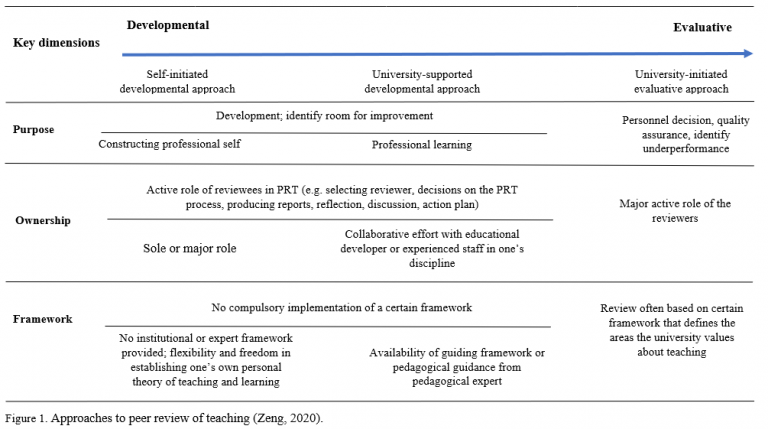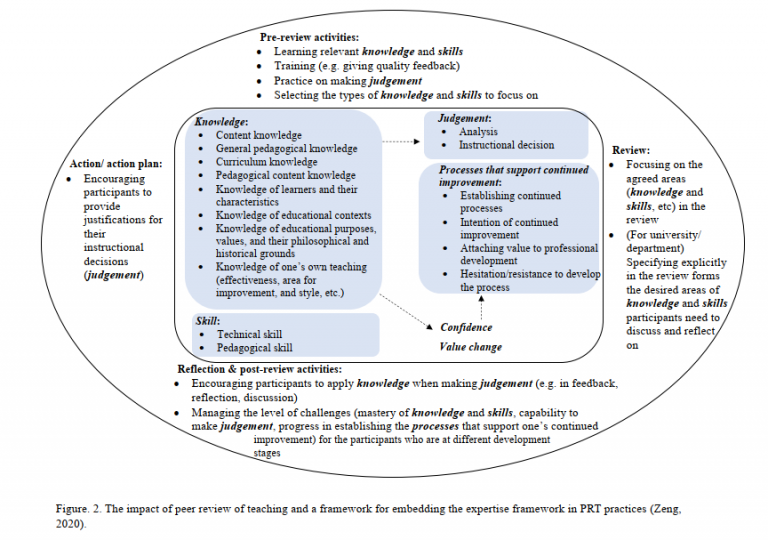[shared_counts]
Author: Dr Lily Min Zeng
Peer Review of Teaching (PRT) is “informed colleague judgement about faculty teaching for either fostering improvement or making personnel decisions” (Chism, 2007, p.3). It was believed to have a highly positive impact on teachers’ teaching development when it is conducted in a reflective manner. (Schön, 1987; Drew & Klopper, 2014). A reflective PRT involves self-regulated and purposeful meditation of one’s own experiences for planned development (Ghaye, 2000; Kolb, 1984; Schön, 1987). It enables teachers to make connections between practice and learning theories, compare their own practices with those of others, proactively analyse and solve problems to gain improvement and longer-term development, and systematically summarise and conceptualise one’s experience to gain a deeper understanding of learning and teaching. It has now been increasingly used in higher education for academics’ professional development as well as personnel decisions. While many other teaching development or evaluation activities are criticised as either disconnected from teachers’ own context sometimes (e.g. short voluntary workshops, practices sharing, etc.) or involving reviewers who do not have a substantive understanding of teaching and subject matter (e.g. student evaluation), PRT is trusted by many scholars as a meaningful triangulation of student evaluation of teaching and self-reflection of the teachers themselves because it is highly contextualised in teachers’ daily work and conducted by teachers’ colleagues who have appropriate understanding of teaching and the subject matter involved (Arreola, 2007; Courneya, D. D. Pratt, & J. Collins, 2008; Iqbal, 2013).
Gosling (2002, 2014) summarised the PRT practices into three models based on the key dimensions of PRT (e.g. who reviews, who is reviewed, the purpose, the relationship between the reviewers and reviewees, who benefits, whose ownership, etc): evaluation, development, and collaborative models. Each involves different organisational procedures, utilisations of the reviewer’s expertise (e.g. content experts or pedagogical experts), usages of the data generated (e.g. for evaluation or for development), etc. In reality, hybrid approaches to PRT were observed more frequently across universities. They indicate a continuum from a teacher’s self-initiated developmental approach to a university-supported developmental approach, and, to a university-initiated evaluative approach (Zeng, 2020) (see Figure 1). The mixed-use of the PRT practices blurred the boundaries of the three models Gosling proposed. Such blurred boundaries bring both challenges and opportunities for the better use of PRT in higher education.

It could be challenging to embed the teaching expertise development framework in practices for a developmental approach to PRT (see Figure 2). Researchers in the field have pointed out four critical dimensions of expertise in teaching: knowledge, skills, judgement, and a process that supports teachers’ superior performance (Dall’Alba, 2018; Stigler & Miller, 2018; Tsui, 2005). A review of the published studies on PRT in higher education since 1990 identified evidence of PRT’s impact on university teachers’ development in all these four dimensions (Zeng, 2020). Although the levels of impact on some subdimensions (e.g. knowledge of learners and their characteristics; pedagogical skills, the establishment of a process for continuing professional development, etc) seemed insufficient still, the less or lack of evidence identified in these sub-dimensions seemed to be partly due to PRT participants’ ineffective use of PRT skills or lack of knowledge needed for providing feedback, conducting reflection, and analysing for judgement. This review also showed the evaluation elements in the PRT had led to some teachers’ resistance or hesitation to engage in future PRT or professional development activities and even harmed teachers’ willingness for continuing engagement with professional development. In spite of the great value of PRT for university teachers’ professional development in teaching, it is often unavoidable in reality having to include some evaluation elements in PRT for management purposes such as for regular performance reviews or personnel decisions. Since the evaluation elements would affect the ownership of the PRT process and the frameworks that guide the PRT activities (e.g. the university defines the values of quality teaching instead of addressing the development needs individual teachers or groups of teachers identify themselves), the space for embedding a developmental framework into the PRT is limited.

However, the blurred boundaries may also bring opportunities when the PRT practices in some dimensions in an evaluation model are adjusted toward the developmental direction. For example, allow more ownership for the reviewees (e.g. invite the reviewees to propose a list of reviewers for the selection by the faculty/university, allow some self-selected procedures in addition to the mandatory steps) and more flexibilities in the guiding framework for PRT (e.g. making available different versions of guiding framework for the reviewees to select one that fits their developmental needs the best).
References
Arreola, R. (2007). Developing a comprehensive faculty evaluation system (3rd ed.). Bolton, MA: Anker Publishing.
Chism, N. V. N. (2007). Peer review of teaching: A sourcebook (2nd ed.). Bolton, MA: Anker Publishing.
Courneya, C., D. D. Pratt, & J. Collins. (2008). Through what perspective do we judge the teaching of peers? Teaching and Teacher Education: An International Journal of Research and Studies, 24(1), 69-79. doi:10.1016/j.tate.2007.01.009
Dall’Alba, G. (2018). Reframing expertise and its development: a lifeworld perspective. In K. Ericsson, R. Hoffman, A. Kozbelt, & A. Williams (Eds.), The Cambridge handbook of expertise and expert performance (pp. 33-39). Cambridge University Press. https://doi.org/10.1017/9781316480748.008
Drew, S., & Klopper, C. (2014). Evaluating faculty pedagogic practices to inform strategic academic professional development: a case of cases. Higher Education, 67(3), 349-367. https://doi.org/10.1007/s10734-013-9657-1
Ghaye, T. (2000). Into the reflective mode: bridging the stagnant moat. Reflective Practice, 1(1), 5-9.
Gosling, D. (2002). Models of peer observation of teaching. Generic Centre: Learning and Teaching Support Network. 8(10), 08. Retrieved September 29, 2014, from https://www.researchgate.net/publication/267687499_Models_of_Peer_Observation_of_Teaching
Gosling, D. (2014). Collaborative peer-supported review of teaching. In J. Sachs & M. Parsell (Eds.), Peer review of learning and teaching in higher education (pp. 13-31). Springer. https://doi.org/10.1007/978-94-007-7639-5
Iqbal, I. (2013). Academics’ resistance to summative peer review of teaching: questionable rewards and the importance of student evaluations. Teaching in Higher Education, 18(5), 557-569. doi:10.1080/13562517.2013.764863
Kolb, D. A. (1984). Experiential learning: Experience as the source of learning and development. Englewood Cliffs, NJ: Prentice Hall.
Schön, D. A. (1987). Educating the reflective practitioner: toward a new design for teaching and learning in the professions (1st ed.). San Francisco, CA: Jossey-Bass.
Stigler, J. W., & Miller, K. F. (2018). Expertise and expert performance in teaching. In K. Ericsson, R. Hoffman, A. Kozbelt, & A. Williams (Eds.), The Cambridge handbook of expertise and expert performance (pp. 431-452). Cambridge University Press. https://doi.org/10.1017/9781316480748.008
Tsui, A. B. M. (2005). Expertise in teaching: Perspectives and issues. In K. Johnson (Ed.), Expertise in second language learning and teaching (pp. 167-189). Palgrave Macmillan.
Zeng, L. M. (2020). Peer review of teaching in higher education: A systematic review of its impact on the professional development of university teachers from the teaching expertise perspective. Educational Research Review, 31, 100333. https://doi.org/https://doi.org/10.1016/j.edurev.2020.100333